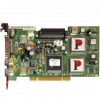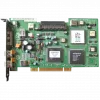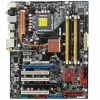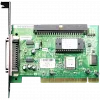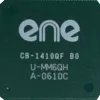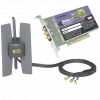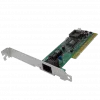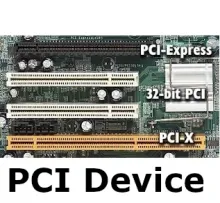
Conventional PCI (part of the PCI Local Bus standard and often shortened to PCI) is a computer bus for attaching hardware devices in a computer. These devices can take either the form of an integrated circuit fitted onto the motherboard itself, called a planar device in the PCI specification, or an expansion card that fits into a slot. The name PCI is an initialism formed from Peripheral Component Interconnect. The PCI Local Bus is common in modern PCs, where it has displaced ISA and VESA Local Bus as the standard expansion bus, and it also appears in many other computer types. Despite the availability of faster interfaces such as PCI-X and PCI Express, conventional PCI remains a very common interface.
The PCI specification covers the physical size of the bus (including the size and spacing of the circuit board edge electrical contacts), electrical characteristics, bus timing, and protocols. The specification can be purchased from the PCI Special Interest Group (PCI-SIG).
Typical PCI cards used in PCs include: network cards, sound cards, modems, extra ports such as USB or serial, TV tuner cards and disk controllers. Historically video cards were typically PCI devices, but growing bandwidth requirements soon outgrew the capabilities of PCI. PCI video cards remain available for supporting extra monitors and upgrading PCs that do not have any AGP or PCI Express slots.
Many devices traditionally provided on expansion cards are now commonly integrated onto the motherboard itself, meaning that modern PCs often have no cards fitted. However, PCI is still used for certain specialized cards, although many tasks traditionally performed by expansion cards may now be performed equally well by USB devices.
Work on PCI began at Intel's Architecture Development Lab circa 1990.
A team of Intel engineers (comprised primarily of ADL engineers) defined the architecture and developed a proof of concept chipset and platform (Saturn) partnering with teams in the company's desktop PC systems and core logic product organizations. The original PCI architecture team included, among others, Dave Carson, Norm Rasmussen, Brad Hosler, Ed Solari, Bruce Young, Gary Solomon, Ali Oztaskin, Tom Sakoda, Rich Haslam, Jeff Rabe, and Steve Fischer.
PCI(Peripheral Component Interconnect) was immediately put to use in servers, replacing MCA and EISA as the server expansion bus of choice. In mainstream PCs, PCI was slower to replace VESA Local Bus (VLB), and did not gain significant market penetration until late 1994 in second-generation Pentium PCs. By 1996 VLB was all but extinct, and manufacturers had adopted PCI even for 486 computers.[2] EISA continued to be used alongside PCI through 2000. Apple Computer adopted PCI for professional Power Macintosh computers (replacing NuBus) in mid-1995, and the consumer Performa product line (replacing LC PDS) in mid-1996.
Later revisions of PCI added new features and performance improvements, including a 66 MHz 3.3 V standard and 133 MHz PCI-X, and the adaptation of PCI signaling to other form factors. Both PCI-X 1.0b and PCI-X 2.0 are backward compatible with some PCI standards.
The PCI-SIG introduced the serial PCI Express in 2004. At the same time they rechristened PCI as Conventional PCI. Since then, motherboard manufacturers have included progressively fewer Conventional PCI slots in favor of the new standard.
